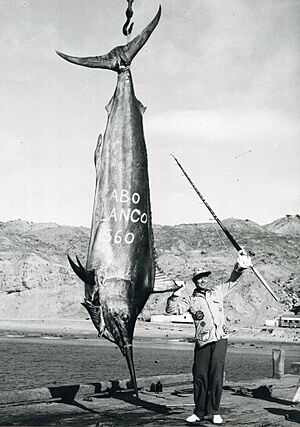Cabo Blanco, Peru facts for kids

Cabo Blanco is a small fishing village located in northwestern Peru. It's about 3 kilometers northwest of El Alto in the Talara Province of the Piura Region. In the past, it was very famous among people who hunted big fish. Today, it's well-known for its amazing surf break. The village gets its name from the light-colored mountains nearby.
Contents
Fishing History
In the 1950s and 1960s, many fishermen traveled to Cabo Blanco to catch huge marlin. Even the famous writer Ernest Hemingway stayed here for over a month at the "Cabo Blanco Fishing Club." He caught a 700-pound marlin while filming a movie based on his book, The Old Man and the Sea.
World Record Catches
Cabo Blanco was home to some incredible fishing records.
- In 1952, a model named Patsy Pulitzer caught a 1,230-pound black marlin here. This was a world record for a woman at the time.
- In 1953, Alfred C. Glassell Jr. caught an even bigger black marlin, weighing about 708 kilograms (1,560 pounds). This fish set a world record for all types of fishing gear.
Surfing Paradise
In 1979, a Peruvian surfer named Gordo Barreda discovered the incredible wave at Cabo Blanco. He visited the village to check out the surf in the area.
The "Peruvian Pipeline"
The wave at Cabo Blanco is known for being hollow and powerful. Surfers often call it the "Peruvian Pipeline." This name comes from the famous Banzai Pipeline wave in Hawaii. Interestingly, ocean swells from Hawaii actually travel all the way to Peru! In the 1990s, surfers would even call Hawaii to find out about swells, knowing they would reach Peru about five days later.
The wave breaks over a mix of sand and rock. During the summer, sand builds up, but winter swells gradually wash it away. This wave inspires a lot of passion among surfers. Even though only about 20 local people live there, many surfers travel from Lima (which is 700 kilometers south) and from all over the world to ride it. With modern weather forecasts and the internet, it's now easy for surfers to know when a big swell is coming. When the waves are good, many surfers gather in one small area to catch them, even though there are other waves nearby.
The Pier
A few years ago, a concrete pier was built for local fishermen. It replaced an old wooden pier that was destroyed by the sea. There was a plan to build the new pier right where the main wave breaks, which would have ruined the wave. Luckily, a better decision was made, and the pier was built about 150 meters north. However, it still affects the very end of the wave ride.
Cabo Blanco in Film
Cabo Blanco was used as a filming location for the movie Undertow (also known as Contracorriente). The film was directed by Javier Fuentes-León and was released in 2010.
See also
 In Spanish: Cabo Blanco (Talara) para niños
In Spanish: Cabo Blanco (Talara) para niños

